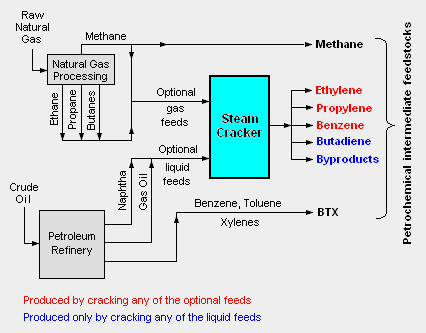Petrochemicals
Steam cracking plant producing ethylene for petrochemical plant feedstock.
Petrochemicals are chemical products made from the hydrocarbons present in raw natural gas and petroleum crude oil. The largest petrochemical manufacturing industries are to be found in the United States, Western Europe, Asia and the Middle East.
A relatively small number of hydyrocarbon feedstocks form the basis of the petrochemical industries, namely methane, ethylene, propylene, butenes, butadiene, benzene, toluene and xylenes.[1][2]
As of 2007, there were 2,980 operating petrochemical plants in 4,320 locations worldwide.[3] The petrochemical end products from those plants include plastics, soaps, detergents, solvents, paints, drugs, fertilizer, pesticides, explosives, synthetic textile fibers and rubbers, flooring and insulating materials and much more.
Petrochemicals are found in such common consumer products as aspirin, cars, clothing, compact discs, video tapes, electronic equipment, furniture, and a great many others.[4]
Feedstocks sources
The major hydrocarbon sources used in producing petrochemicals are:[1][2][5][6]
- Methane, ethane, propane and butanes: Obtained primarily from natural gas processing plants.
- Naphtha obtained from petroleum refineries.
- Benzene, toluene and xylenes, as a whole referred to as BTX and primarily obtained from petroleum refineries by extraction from the reformate produced in catalytic reformers.
- Gas oil obtained from petroleum refineries.
Methane and BTX are used directly as feedstocks for producing petrochemicals. However, the ethane, propane, butanes, naphtha and gas oil serve as optional feedstocks for processing in steam-assisted thermal cracking plants known as steam crackers to produce these intermediate petrochemical feedstocks:
- Ethylene
- Propylene
- Butenes and butadiene
- Benzene
In 2007, the amounts of ethylene and propylene produced in steam crackers were about 115 Mt (megatonnes) and 70 Mt, respectively.[7] The output ethylene capacity of large steam crackers ranged up to as much as 1.0 – 1.5 Mt per year.[8][9]
The adjacent diagram depicts the all of the major petrochemical feedstocks and their sources.
Worldwide usage of steam cracking feedstock sources and their effect on steam cracking yields
As of 2004, the percentage of the worldwide steam cracking plants using each of the optional steam cracking feed sources was:
- Ethane: 35%
- Propane: 9%
- Butanes: 3%
- Naphtha: 45%
- Gas oil: 5%
- Other: 3 %
The effect of feedstock selection upon the yields of steam cracking products is summarized in the table below:
| Product Yields | ||||||||||||||||||||||||||||||||||||||||||||||||||||||||||||
|---|---|---|---|---|---|---|---|---|---|---|---|---|---|---|---|---|---|---|---|---|---|---|---|---|---|---|---|---|---|---|---|---|---|---|---|---|---|---|---|---|---|---|---|---|---|---|---|---|---|---|---|---|---|---|---|---|---|---|---|---|
| Feedstock source |
Ethylene weight % |
Propylene weight % |
Butadiene weight % |
Aromatics (a) weight% |
Other (b) weight % | |||||||||||||||||||||||||||||||||||||||||||||||||||||||
| Ethane | 84.0 | 1.4 | 1.4 | 0.4 | 12.8 | |||||||||||||||||||||||||||||||||||||||||||||||||||||||
| Propane | 45.0 | 14.0 | 2.0 | 3.5 | 35.5 | |||||||||||||||||||||||||||||||||||||||||||||||||||||||
| Butane | 44.0 | 17.3 | 3.0 | 3.4 | 32.3 | |||||||||||||||||||||||||||||||||||||||||||||||||||||||
| Naphtha (c) | 34.4 | 14.4 | 4.9 | 14.0 | 32.3 | |||||||||||||||||||||||||||||||||||||||||||||||||||||||
| Gas oil (d) | 25.5 | 13.5 | 4.9 | 12.8 | 43.3 | |||||||||||||||||||||||||||||||||||||||||||||||||||||||
| (a) Includes benzene, toluene, xylenes and any other aromatics. (b) Includes hydrogen, methane, butenes, non-aromatic portion of pyrolysis gasoline and fuel oil. Feedstocks and example petrochemical productsThe table below includes some representative examples of the petrochemical end products produced from the eight hydrocarbon feedstocks – methane, ethylene, propylene, butenes, butadiene, benzene, toluene and xylenes:
References
|
||||||||||||||||||||||||||||||||||||||||||||||||||||||||||||
